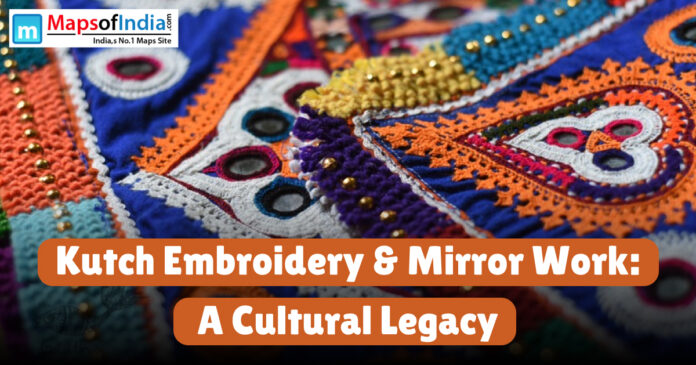In Gujarat’s arid but richly cultural landscape, the Kutch district clearly shows India’s variety of artistic traditions. Mirror-adorned embroidery has gained a lot of recognition for adding a lively representation of the region’s community, history and imagination to their textiles.
Origins and Historical Context
The Rabari, Ahir, Sindhi and Jat tribes’ migration influenced the development of Kutch embroidery which began several generations past. Their special techniques and motifs combined over the years to shape the quilt styles that are famous today. Originally, embroidery was an everyday activity in the home, where women worked on dowry items, useful textiles and things for ceremonies and taught their skills to others.
Because the area lies near trade routes, cultural influence from Persia, Mughal and Central Asia has shown up in the embroidery’s design and methods. Because of this fusion, the embroidery craft in Kutch gained a unique style seen today.
Distinctive Styles and Techniques
You can see how Kutch embroidery reflects the cultures of its makers through the many ranges of styles:
- Suf: Its designs begin with geometrical patterns and use counted thread work to build exact symmetrical shapes that may look like architectural ornaments.
- Khaarek: It is famous for being intricate because of its tight stitches and straight lines which are usually applied everywhere on the fabric.
- Paako: Paako refers to something solid and the embroidery uses small, careful stitches with striking colors that create bold, jutting designs.
- Rabari: The Rabari style is used by the Rabari community; it features mirrors and designs based on their own myths and usual habits, showing their history of migration.
- Ahir: Ahir embroidery which uses flowers and pictures of animals, is often bright and stands out since it has many mirrors and colorful threads, representing their farming way of life.
- Mutwa: This style is particular because of its fine thread work, gentle colors and ornaments made from tiny mirrors.
The Role of Women Artisans and Generational Continuity
An especially important aspect of Kutch embroidery and mirror work is that it is traditionally passed down through generations, which has made women the leaders of their community’s heritage. In the past, girls started to learn through their mothers and grandmothers, often at around six or seven years old. It helps students improve their skills and also feel more connected, proud and included in a community. Thanks to their creativity and strength, women artisans have saved these traditions and further adapted them for use today. Handing down their knowledge allows Kutch embroidery to stay a cherished sign of their culture, strength and skill.
The Significance of Mirror Work
Mirror work is an important characteristic of Kutch embroidery and is known as ‘Abhla Bharat’. Artisans originally worked with mica or beetle wings for mirrors which later included glass mirrors. Mirrors like these are carefully sewn onto fabrics for their beauty as well as for what they symbolize. Most people believe that they keep away negative forces and create a radiant shine on clothing and fabrics.
The use of mirrors changes from style to style. As an example, Rabaris craft artworks using squares, triangles and diamonds as mirrors to achieve different shapes. Unlike the previous styles, Ahir embroidery mixes mirrors into its flowers, making the designs more noticeable.
Cultural and Social Relevance
In addition to being exquisite, Kutch needlework has a unique cultural significance. It facilitates the sharing of personal narratives about one’s religion, residence, and experiences. Numerous types of embroidered items, such as apparel or purses, are used at ceremonies, weddings, and cultural events. It also helps women work as a group, talk and teach their skills to each other.
For the Rabari community, embroidery plays a major role in how a woman is seen by others. Cholis are both clothing and a way to share a person’s story and dreams.
Contemporary Adaptations and Global Recognition
Today, Kutch embroidery is used in fashion and home design around the world. Artisans and designers work together to create modern and trendy products by mixing old styles with new looks. This helps keep the craft alive and gives artisans a steady income.
One famous artisan, Pabiben Rabari, has brought new ideas to Kutch embroidery by making styles like ‘Hari Jari’ and products like the ‘Pabi Bag,’ which are known worldwide. This shows that Kutch embroidery is always evolving and remains attractive to people everywhere.
Preservation Efforts and Challenges
Shown around the world, the embroidery from Kutch now encounters issues related to manufacturing on a large scale, shifting buying habits, and many of the younger generations moving away to cities. Many organizations and cooperatives are making efforts to help craftspeople by arranging workshops, exhibitions and fair-trade activities. The goal is to keep the important craft of Kutch embroidery from dying out.
Shrujan Trust helped bring back and preserve the embroidery heritage in Kutch. They have given training and helped artisans sell products, which has boosted the status of women in different villages by ensuring that future generations will learn these skills.
Conclusion
Mirror work and Kutch embroidery go beyond decoration; they represent the history, identity and fortitude of the community. As we admire the exquisite embroidery and glistening mirrors, we pay tribute to the individuals, traditions, and artistry that go into each piece. Promoting and Conserving Kuttis’ heritage guarantees that future generations will be fascinated by its colors and traditions.




